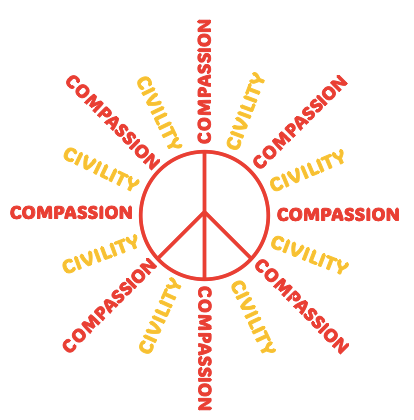MINDFULNESS BLOG HEATH BLOG KINDNESS BLOG QUALITY OF LIFE BLOG
The Up Deeds blog
Our blog posts are created by those that share the same call to give back to others.
We give them the full credit they are due, and links so you can benefit from other information they share.

Civility, Peace, and Compassion: Understanding Our Differences and Building a Better Tomorrow
By Up Deeds
In today's increasingly polarized world, the concepts of civility, peace, and compassion often appear elusive. While some individuals naturally embody these traits, others struggle to embrace them fully. But what do these terms really mean, and why do they elicit such different responses in different people?
Defining Civility, Peace, and Compassion
Civility refers to the respect and courtesy we show to others, even amid disagreements. It's about maintaining a level of decorum in our interactions, ensuring that communication remains civil and constructive. Peace, on the other hand, is the absence of conflict and turmoil, both internally and externally. It fosters an environment where individuals feel safe and valued. Compassion extends beyond mere sympathy; it is the genuine concern for the suffering of others and the desire to relieve that suffering.
Perceptions Vary
The interpretation of civility, peace, and compassion can differ widely among individuals shaped by their unique experiences, cultural backgrounds, and personal beliefs. For some, civility may be a straightforward matter of polite conversation, while for others, it might require deeper understanding and engagement. Similarly, notions of peace can range from superficial harmony to profound reconciliation, and compassion can be seen as mere charity or a deeper call to action for social justice.
Fostering Civility, Peace, and Compassion
Improving civility, peace, and compassion in our communities requires intentional efforts. Here are some practical steps we can take:
1. Education and Awareness: Schools and community organizations should prioritize teaching conflict resolution and empathy, helping individuals understand diverse perspectives.
2. Encouraging Dialogue: Creating spaces for open dialogue allows individuals to express their views while also listening to others. Town halls, discussion groups, and forums can facilitate this process.
3. Modeling Behavior: Leaders in our communities—whether they are politicians, educators, or family members—should model civility and compassion in their interactions.
4. Volunteering and Community Engagement: Encouraging participation in community service can foster a deeper understanding and connection to those who may experience hardship, nurturing compassion.
5. Mindfulness Practices: Promoting mindfulness can help individuals manage their emotions and responses, leading to more thoughtful and peaceful interactions.
Imagining a Compassionate Future
If more individuals embraced civility, peace, and compassion, our communities could transform dramatically. We would see reduced conflict and an increase in collaboration, resulting in solutions to social issues that arise from misunderstanding and division. Neighbors would interact more positively, leading to stronger support systems and networks of care. Environments would be more inclusive, with diverse voices being valued and respected. Ultimately, communities could develop into havens of support, innovation, and resilience.
While the path to greater civility, peace, and compassion may seem challenging, it is also an achievable goal. By understanding our differences, fostering dialogue, and committing to personal and collective growth, we can build a more compassionate society—one that not only tolerates diversity but thrives on it.
Would you like to receive a monthly uplifting and helpful blog?
That's great to hear, just click the button to sign up.
